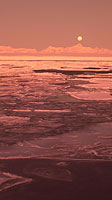

 | |||||||||||||||
|
|
Journals 2008/2009Roy Arezzo
July 18, 2008 I washed some of the mud out of my clothes and geared up for another station. We transited through the ice to arrive at Station F around noon, the start of my shift, and after a quick lunch we had the Megacore in the water. While waiting to prep the mud cores, I set up a fish tank in the Aquarium Lab and lashed it under the table. We will use a hose with a gentle stream to move seawater through the tank. We will take some of surface sediment that we can spare from the Megacore and box core to line the bottom. I am hoping by tomorrow we will have a good layer of sediment settled at the bottom of a clear tank to serve as food for deposit feeders (critters that live of the decaying organic matter by eating mud like earthworms). It is another amazingly clear day on the Peninsula, atypical winter weather. We are close to some small islands and able to get more great shots of the full moon over the peaks at sunrise and sunset, which follows soon after. Our watch saw a lot of different activity today and I participated in deploying a Megacore, Kasten Core and Box core. All of which takes a fair amount of physical assembling and disassembling for each deployment. The tucker trawl came up with some nice plankton soup and I need to find time to photograph and speak to Linda about what we do with all that fine zooplankton. The Blake trawl (bottom trawl) is everyone's favorite activity, and I am always interested to see the random folks that emerge from the engine room and tucked away ship's spaces just to see what came up in the net. The trawl results did not disappoint, and the highlights were giant spiky worms (polycheates), a different species of octopus and an odd treat from the sky. While sifting we found a bird band and soon after a femur bone to match. We will need to call it in and it is likely that the leg belonged to a larger bird, maybe a penguin or an albatross.
I am concluding this entry with a segment from the Chief Scientist's weekly science report, which came out today. Having been published a bunch and funded by the NSF he certainly can get our first station wrapped up more concisely than I can... After ironing out a few first-day glitches, oceanographic operations have gone very smoothly. During 2.5 days at Station G, we collected 4 box cores, 7 Megacores and one Kasten core, and conducted two Tucker trawls, one Blake trawl, two CTDs and four bottom-camera (or "yoyo") transects. We also deployed our time-lapse camera system, which will remain on the seafloor at 600 m for the next seven months, making a digital image every 12 h to record the abundance and activities of megabenthos and bioturbation features, and the occurrence of phytodetritus. Our work at Station G has been completely successful due to excellent support from Raytheon and Ship personnel, and hard work from the scientific party. We have all also thoroughly enjoyed working in the ice, relishing the novel experience of a motionless ship on a motionless ocean, and the unparalleled beauty of winter in Antarctica.
|
||||||||||||||


